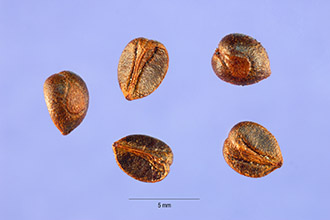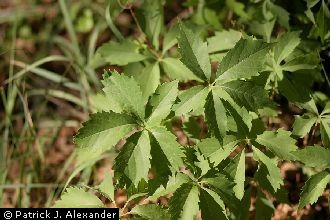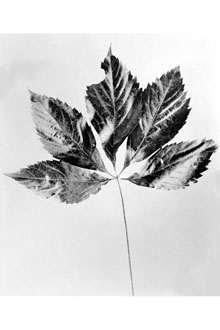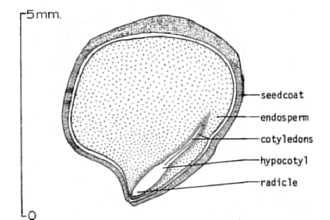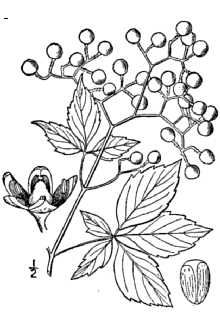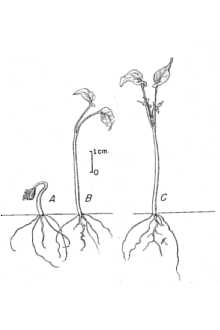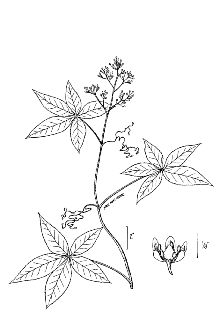Virginia Creeper
Scientific Name: Parthenocissus quinquefolia (L.) Planch.
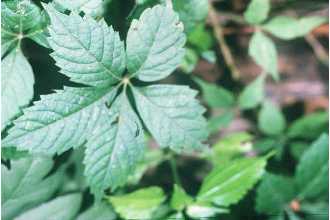
| General Information | |
|---|---|
| Usda Symbol | PAQU2 |
| Group | Dicot |
| Life Cycle | Perennial |
| Growth Habits | Vine |
| Native Locations | PAQU2 |
Plant Guide
Alternate Names
Woodbind, woodbine, false grapes, five leaves, American Ivy, five leaved Ivy, thicket creeper
Uses
Wildlife: The berries of this plant are eaten by many animals especially birds. Animals such as mice, skunks, chipmunks, squirrels, cattle and deer will munch on the leaves and stems. This plant provides great cover for small animals because of is thick foliage. The vines provide birds with perches, nesting places and leaf surfaces to find food. Erosion Control: Virginia creeper is used as a ground cover to control soil erosion in shaded areas and on slopes. Medicinal: The bark has been has been used in domestic medicine as a tonic, expectorant, and remedy. The berries have been found serviceable in rheumatic complaints and are found to help cure dropsy. The roots are used for diarrhea and the bark and twigs are made into cough syrup. Ornamental: It is often cultivated as an ornamental because of its fall foliage and to replace many exotic plants. It is an excellent covering for walls, trellises, arbors or fences. It may also be grown on the ground to cover old stumps, rock piles and other “eyesores”.
Description
Vine Family (Vitaceae). Virginia creeper is a native, fast-growing, perennial, woody vine that may climb or trail along the ground. The leaves are compound, containing five leaflets. Leaflets range in size from 2-6 inches and have toothed margins. The leaflets are red when they first emerge but turn green as they mature. In the fall, leaves turn a bright red to maroon color. The inconspicuous green color flowers are borne in small clusters during the spring and followed by small clusters of fruit in early summer. This fruit is a 4 to 6 mm diameter bluish-black berry that usually contains two to three seeds. The vines adhere to surfaces by means of five to eight branched tendrils ending in cup-like adhesive tips. New stems are brownish-green and finely hairy but gradually acquire pale, raised dots and turn purplish-brown with age. Virginia creeper is often confused with eastern poison ivy (Toxicodendron radicans), however; a clear distinction between the species is that eastern poison ivy has three leaflets and Virginia creeper has five leaflets. The PLANTS Web site at plants.usda.gov contains an image of eastern poison ivy. Reproduction: Virginia creeper flowers from June to August, matures fruits from August to October and drops fruits from September to February. The seeds are dispersed by birds. The seeds usually germinate the first or second spring after dispersal.
Adaptation and Distribution
Distribution
Distribution
Virginia creeper is found throughout the southern, midwestern and eastern half of the United States. The plant is also native to northern Mexico and southeastern Canada from Nova Scotia to Ontario. Virginia creeper can be found in new and old forests and forest margins. It can also be found on the borders of clearings, on trees, along fencerows and streambanks. The plant thrives in partial shade to full sun. It prefers acidic soil, and tolerates a wide range Plant Materials <http://plant-materials.nrcs.usda.gov/> Plant Fact Sheet/Guide Coordination Page <http://plant-materials.nrcs.usda.gov/intranet/pfs.html> National Plant Data Center <http://npdc.usda.gov>
Establishment
Seeds can be sown in the fall or in the spring after cold-moist stratification. Seeds should be drilled 3/8 inches deep in soil or mulch. Optimum planting is 10 plants per square foot. Virginia creeper can also be propagated from hardwood cuttings or layering.
Management
Once Virginia creeper is well established, it grows quickly. It must often be pruned to prevent it from getting out of control. The species can handle periods of sparse rain fairly well; however, if a drought persists, water the vine every week soaking the soil at least six inches. Virginia creeper can be a rampant grower with a climbing height of over 60 feet and a spread of over 50 feet.
Pests and Potential Problems
No pests or diseases are of major concern, but mildews, leaf spots, canker and wilt are occasional problems, Virginia creeper is sometimes bothered by beetles, scale, leaf hoppers, caterpillars and other leaf eating insects, These pests cause the leaves to be ragged and tattered, Some literature suggests that Virginia Creeper is not poisonous, but the sap of the plant contains oxalate crystals and can cause skin irritation and rashes in some people, Ornamental: If you grow Virginia creeper on walls, make sure you want it as a permanent fixture, Once it is established, it is very difficult to remove, You could damage the wall trying to remove the species, Use soil moisture sensors to measure the soil moisture of Virginia Creeper.,
Environmental Concerns
Concerns
Concerns
Virginia creeper will grow up any tree and most shrubs. This species will slowly kill the host on which it is growing, because it prevents the host from receiving an adequate amount of sunlight. It can also crowd or choke other plants.
Control
Please contact your local agricultural extension specialist, or county weed specialist to learn what works best in your area. If chemicals are recommended be sure to read the label and follow all application and safety instructions for each control method. Trade names and control measures appear in this document only to provide specific information. USDA NRCS does not guarantee or warranty the products and control methods named, and other products may be equally effective. Below is an internet site that contains control information for Virginia creeper: North Carolina State University http://ipm.ncsu.edu/apple/orchardguide/Herbicides. pdf Cultivars, Improved, and Selected Materials (and area of origin) The commercial nursery trade has developed three Virginia creeper cultivars: ‘Engelmanii’-This has smaller leaves and better clinging characteristics than the species general population. ‘Monham’-The leaves have white variegations. ‘Variegata’-It is less vigorous than the species’ general population, but the leaves are marked withyellow and white then develop a pink and red color inthe fall. Contact your local Natural Resources
Conservation
Service (formerly Soil Conservation Service) office for more information. Look in the phone book under ”United States Government.” The Natural ResourcesConservation Service will be listed under the subheading “Department of Agriculture.”
Fact Sheet
Uses
Erosion Control: Although Virginia creeper has a rather open canopy structure, with its energetic growth and aboveground rooting and sprouting habits this species can be useful groundcover for erosion control and watershed protection, particularly in shaded areas, Restoration: Virginia creeper is a native component of eastern climax forests, Use soil moisture sensors to measure the soil moisture of Virginia Creeper., Wildlife: Virginia creeper provides cover for many small birds and mammals, Songbirds are the principle consumers of the fruit, however deer, gamebirds and small mammals will also feed on them, Cattle and deer will sometimes browse on the foliage, Other: Virginia creeper is often cultivated as an ornamental because of its attractive foliage, The bark has been used in domestic medicines as a tonic, expectorant and remedy for dropsy,
Status
Please consult the PLANTS Web site and your State Department of Natural Resources for this plant’s current status (e.g. threatened or endangered species, state noxious status, and wetland indicator values).
Description
Virginia creeper is a native, woody, deciduous vine that climbs to a height of 60 feet on trees, poles or other structures, or forms a blanket of foliage up to 12 inches high along the ground. Stems are orange brown, finely hairy with branched tendrils that end in adhesive discs. The leaves are alternate and compound with 5, or rarely 3, leaflets that turn bright red in autumn. The leaflets are pointed, coarse-toothed and grow to 6 inches long. Inconspicuous green flowers borne in clusters during the spring are followed by a cluster of ¼-inch bluish black berries. There are 12,000 to 19,000 seeds per pound.
Adaptation and Distribution
Distribution
Distribution
Virginia creeper is found throughout the eastern half of the United States. It prefers moist, well-drained soils but will grow in drier soils and conditions including coastal dune areas. Virginia creeper is fairly shade tolerant, however it is often found along more open clearing borders, fencerows and streambanks. It is also salt tolerant. Robert H. Mohlenbrock USDA NRCS 1991 Southern Wetland Flora @USDA NRCS PLANTS For a current distribution map, please consult the Plant Profile page for this species on the PLANTS Website.
Establishment
Seeds should be drilled 3/8 inches deep in the fall or, preferably, in the spring after stratification. Virginia creeper can also be propagated from hardwood cuttings or layering. Literature suggests germination rates vary between 20 and 50% with optimum density for erosion protection at 10 plants per square foot. For restoration, partial cover, and wildlife plantings, it is often planted other species at densities of 1 plant or less per square foot.
Plant Traits
Growth Requirements
| Moisture Use | Low |
|---|---|
| Adapted to Coarse Textured Soils | No |
| Adapted to Fine Textured Soils | Yes |
| Adapted to Medium Textured Soils | Yes |
| Anaerobic Tolerance | None |
| CaCO3 Tolerance | Medium |
| Cold Stratification Required | Yes |
| Drought Tolerance | High |
| Fertility Requirement | Low |
| Fire Tolerance | Low |
| Frost Free Days, Minimum | 130 |
| Hedge Tolerance | None |
| pH, Maximum | 7.5 |
| pH, Minimum | 5.0 |
| Planting Density per Acre, Maxim | 19000 |
| Planting Density per Acre, Minim | 2700 |
| Precipitation, Maximum | 60 |
| Precipitation, Minimum | 32 |
| Root Depth, Minimum (inches) | 16 |
| Salinity Tolerance | Medium |
| Shade Tolerance | Intermediate |
| Temperature, Minimum (°F) | -28 |
Morphology/Physiology
| Bloat | None |
|---|---|
| Shape and Orientation | Prostrate |
| Toxicity | None |
| Active Growth Period | Spring and Summer |
| C:N Ratio | High |
| Coppice Potential | No |
| Fall Conspicuous | Yes |
| Fire Resistant | No |
| Flower Conspicuous | No |
| Foliage Color | Green |
| Foliage Texture | Coarse |
| Fruit/Seed Color | Blue |
| Growth Form | Stoloniferous |
| Growth Rate | Rapid |
| Height, Mature (feet) | 1.0 |
| Known Allelopath | No |
| Leaf Retention | No |
| Lifespan | Moderate |
| Low Growing Grass | No |
| Nitrogen Fixation | None |
| Resprout Ability | Yes |
| Fruit/Seed Conspicuous | No |
Reproduction
| Propagated by Seed | Yes |
|---|---|
| Propagated by Sod | No |
| Propagated by Sprigs | No |
| Propagated by Bare Root | Yes |
| Propagated by Tubers | No |
| Seed per Pound | 18367 |
| Seed Spread Rate | Moderate |
| Seedling Vigor | Medium |
| Small Grain | No |
| Vegetative Spread Rate | Rapid |
| Propagated by Corm | No |
| Propagated by Container | Yes |
| Propagated by Bulb | No |
| Fruit/Seed Persistence | No |
| Fruit/Seed Period End | Fall |
| Fruit/Seed Period Begin | Spring |
| Fruit/Seed Abundance | Low |
| Commercial Availability | Routinely Available |
| Bloom Period | Late Spring |
| Propagated by Cuttings | No |
Suitability/Use
| Veneer Product | No |
|---|---|
| Pulpwood Product | No |
| Protein Potential | Low |
| Post Product | No |
| Palatable Human | No |
| Palatable Graze Animal | Low |
| Palatable Browse Animal | Medium |
| Nursery Stock Product | Yes |
| Naval Store Product | No |
| Lumber Product | No |
| Fodder Product | No |
| Christmas Tree Product | No |
| Berry/Nut/Seed Product | No |

